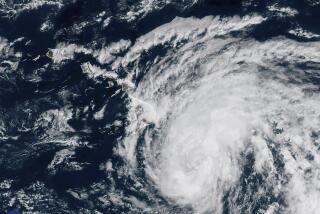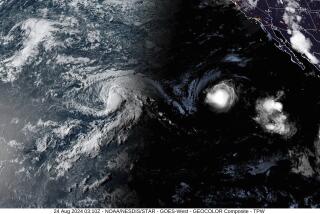Pacific Cyclones as Vile as Atlantic Cousins : Weather: Born off Mexico and Guatemala, they rarely reach Hawaii. But Hurricane Iniki packed a wallop as intense as Andrew’s.
- Share via
Cyclone, typhoon, baguio, willy-willy, cordonazo. No matter what name they bear, Pacific hurricanes strike with the same vicious winds, heavy rains and swollen tides as those in the Atlantic.
Hurricane Iniki, which bore down on the Hawaiian Islands Friday night, is a typical northeastern Pacific hurricane, spawned early this week in the warm waters off the west coast of Mexico and Guatemala, between 10 and 20 degrees north latitude.
Like all such storms, it began innocently as gently whirling winds and dropping atmospheric pressure. It fed on energy from the warm, moist air over the Pacific, was recognized as a tropical depression on Sunday and upgraded to a tropical storm two days later, then declared a hurricane on Wednesday.
Rated a Category 4 hurricane, which packs winds from 131 to 155 miles per hour, Iniki is at least as powerful as Hurricane Andrew, which slammed into Florida last month and hurled itself across the Gulf of Mexico to hit Louisiana. Category 5 is the worst, with sustained winds above 155 m.p.h. The Iniki’s winds have consistently topped 145 m.p.h., with gusts to 175 m.p.h.
The area where Iniki began is the second most common basin for hurricane formation, accounting for 18% of all hurricanes globally, according to meteorologist William M. Gray of Colorado State University. Only the northwestern Pacific, where 30% of all hurricanes are born, produces more.
The Atlantic Ocean, in contrast, accounts for only 12% of the total--though it is here that most of the damaging storms that strike the U.S. begin. The most common months for hurricanes anywhere in the Northern Hemisphere are August and September.
Storms spawned off Mexico, such as Iniki, typically travel northwestward off the Pacific Coast of North America. Those that last long enough to strike the Mainland typically have been weakened by passing over cooler water, leaving them little more than intense rainstorms that sometimes drench Southern California.
The farther south in the Pacific that the storms form, the more westward their paths take them. Occasionally, perhaps once every five to 10 years, Gray said, atmospheric conditions push them farther west and they make it as far as Hawaii.
Some scientists believe that the strength and intensity of hurricanes formed in this region of the Pacific are greater during El Nino conditions, when water temperatures are slightly higher, but this possibility is still the subject of much debate.
“But there are more of them in El Nino years,” such as this one, said Gray.
Hurricanes in the western Pacific, where they are called typhoons, tend to be “a little bit bigger and broader” than those like Iniki, Gray said, and also may have slightly lower air pressures.
But overall, he said, “they are more alike than they are different. . . . A tropical storm is a tropical storm.”
Riding Out the Storm
Hurricane Iniki (pronounced ee-nee’-kee) bears down on Hawaii. The first hurricane to hit the island chain in 10 years, it developed to the south early in the week. (Circles indicate areas where hurricane warnings were issued.) 1. Oahu, where Honolulu and the Pearl Harbor naval base are located, is home to more than 800,000 people. Authorities ordered the evacuation of all homes and other buildings on Oahu within 300 feet of the ocean. That included the high-rise hotels of world-famous Waikiki Beach. 2. Kauai’s 50,000 residents are concentrated mostly on the eastern and southeastern shore. 3. Niihau is a less-developed island, is privately owned with fewer than 500 residents, most of them native Hawaiians.
More to Read
Sign up for Essential California
The most important California stories and recommendations in your inbox every morning.
You may occasionally receive promotional content from the Los Angeles Times.









